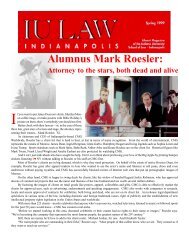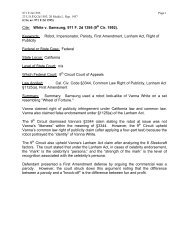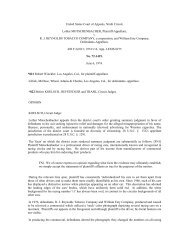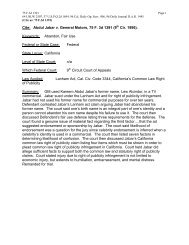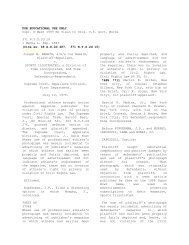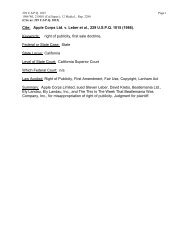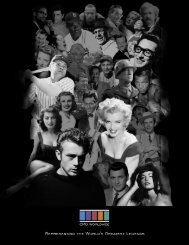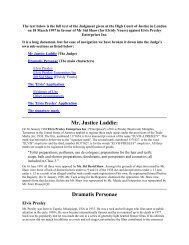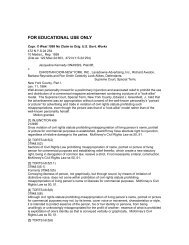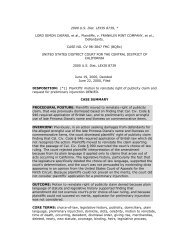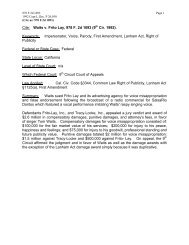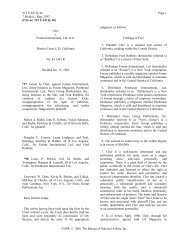Hustler v. Falwell.pdf - Mark Roesler
Hustler v. Falwell.pdf - Mark Roesler
Hustler v. Falwell.pdf - Mark Roesler
Create successful ePaper yourself
Turn your PDF publications into a flip-book with our unique Google optimized e-Paper software.
if Valentino's name had not been used. This unauthorized use in a "work of<br />
fiction" which respondents knew was not an accurate portrayal of Valentino's<br />
life allegedly constituted a misappropriation [*863] of Valentino's right of<br />
publicity. n1 For this allegedly tortious conduct, appellant seeks damages and<br />
injunctive relief. n2<br />
- - - - - - - - - - - - - - - - - -Footnotes- - - - - - - - - - - - - - - - - -<br />
n1 In his petition for hearing, appellant summarized his claim: "In essence,<br />
Petitioner alleges that defendants have created a 'product,' a fictionalized<br />
photoplay, into which, for their own gain, they appropriated the name, likeness,<br />
and identity of Rudolph Valentino in order to make their product commercially<br />
viable and to ensure a 'sale' of their product."<br />
n2 Specifically, appellant prayed for a permanent injunction restraining<br />
respondents from "commercially exhibiting . . . any false, untrue, fictionalized<br />
or fabricated film which purports to depict a portion of the life of Rudolph<br />
Valentino and/or which embodies the use of the name, likeness, and reputation<br />
of<br />
Rudolph Valentino," and "from using the name, likeness or reputation of<br />
Rudolph<br />
Valentino in any manner for the purposes of advertising any film, product, or<br />
services or for the purposes of solicitation of commercial advertising for any<br />
PAGE 43<br />
25 Cal. 3d 860, *863; 603 P.2d 454, **456;<br />
160 Cal. Rptr. 352, ***354; 5 Media L. Rep. 2208 FOCUS<br />
film, product, or services . . . ."<br />
- - - - - - - - - - - - - - - - -End Footnotes- - - - - - - - - - - - - - - - -<br />
Respondents demurred to appellant's complaint, asserting that it failed to<br />
state facts sufficient to constitute a cause of action. The trial court<br />
sustained the demurrer with leave to amend. However, the court offered to<br />
sustain the demurrer without leave to amend and dismiss the complaint if<br />
appellant wished to challenge the court's ruling. Appellant elected to stand on<br />
the unamended complaint and his complaint was dismissed. This appeal<br />
followed.<br />
II<br />
In reviewing the sufficiency of a complaint following a trial court's<br />
sustaining of a general demurrer, the allegations in the complaint are assumed<br />
to be true. (Gill v. Curtis Publishing Co. (1952) 38 Cal.2d 273, 275 [239 P.2d<br />
630]; Hendrickson v. California Newspapers, Inc. (1975) 48 Cal.App.3d 59, 61<br />
[121 Cal.Rptr. 429].) If the allegations so construed state any cause of action,<br />
then a trial court commits error when it sustains a demurrer and dismisses the<br />
complaint. n3<br />
- - - - - - - - - - - - - - - - - -Footnotes- - - - - - - - - - - - - - - - - -<br />
n3 The description of respondents' conduct and state of mind set forth in<br />
section I, ante, was drawn from appellant's complaint and subsequent<br />
submissions<br />
in this action. While the sufficiency of the complaint must be judged on the



